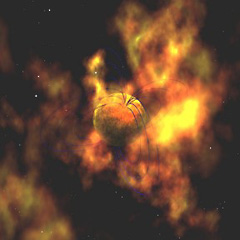Yes, Virginia, There is a Magnetar!
Yes, Virginia, There is a Magnetar!
| 26 October 1998 |
 Credit: NASA |
A star, located 40,000 light-years from Earth, is generating the most intense magnetic field yet observed in the Universe, according to an international team of astronomers led by scientists at NASA's Marshall Space Flight Center in Huntsville, AL. The discovery confirms the existence of a special class of neutron stars dubbed "magnetars." A neutron star is a burned-out star roughly equal in mass to the Sun that has collapsed through gravitational forces to be only about 10 miles across. A magnetar has a magnetic field estimated to be one thousand trillion times the strength of Earth's magnetic field. Magnetars have a magnetic field that is about 100 times stronger than the typical neutron star.
The discovery was published in an issue of the journal Nature, and was made by a team of astronomers led by Dr. Chryssa Kouveliotou of the Universities Space Research Association. "This finding should help us better calculate the rate at which stars die and create the heavier elements that later become planets and other stars," Kouveliotou said.
Kouveliotou and her team determined the strength of the magnetic field by combining data gathered by NASA's Rossi X-Ray Timing Explorer satellite with data from the Advanced Satellite for Cosmology and Astrophysics, a collaborative mission between Japan and the United States.
"The magnetic field generated by this star is truly incredible," Kouveliotou said. "It is so intense that it heats the surface to 18 million degrees Fahrenheit. Periodically, the field drifts through the crust of the neutron star, exerting such colossal forces that it causes a 'starquake.' The 'starquake' energy is then released as an intense burst of low-energy gamma rays."
Since these bursts happen quite often and the bulk of their energy is in low-energy gamma-rays (what astronomers call "soft gamma-rays"), the objects associated with them had been named Soft Gamma Repeaters. When bursting, Soft Gamma Repeaters are among the brightest objects in the sky, giving off as much energy in a single second as the Sun does in an entire year. The magnetar in question, called SGR 1806-20 by astronomers, was first discovered when it emitted soft gamma-ray bursts.
Astronomers have debated the origin of Soft Gamma Repeaters since they were first observed in 1979. With this discovery, however, researchers believe the origin of Soft Gamma Repeaters lies in the 'starquake' phenomena of magnetars. The magnetar theory was first proposed in 1992 by astrophysicists Dr. Robert Duncan of the University of Texas at Austin and Dr. Christopher Thompson of the University of North Carolina at Chapel Hill.

